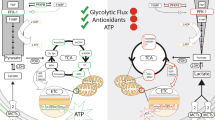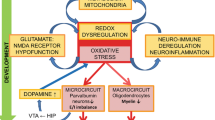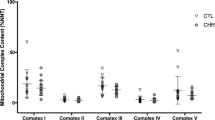Abstract
The etiology and pathophysiology of schizophrenia remain unknown. A parallel transcriptomics, proteomics and metabolomics approach was employed on human brain tissue to explore the molecular disease signatures. Almost half the altered proteins identified by proteomics were associated with mitochondrial function and oxidative stress responses. This was mirrored by transcriptional and metabolite perturbations. Cluster analysis of transcriptional alterations showed that genes related to energy metabolism and oxidative stress differentiated almost 90% of schizophrenia patients from controls, while confounding drug effects could be ruled out. We propose that oxidative stress and the ensuing cellular adaptations are linked to the schizophrenia disease process and hope that this new disease concept may advance the approach to treatment, diagnosis and disease prevention of schizophrenia and related syndromes.
This is a preview of subscription content, access via your institution
Access options
Subscribe to this journal
Receive 12 print issues and online access
$259.00 per year
only $21.58 per issue
Buy this article
- Purchase on Springer Link
- Instant access to full article PDF
Prices may be subject to local taxes which are calculated during checkout


Similar content being viewed by others
References
Middleton FA, Mirnics K, Pierri JN, Lewis DA, Levitt P . Gene expression profiling reveals alterations of specific metabolic pathways in schizophrenia. J Neurosci 2002; 22: 2718–2729.
Hakak Y . Genome-wide expression analysis reveals dysregulation of myelination-related genes in chronic schizophrenia. Proc Natl Acad Sci USA 2001; 98: 4746–4751.
Torrey EF, Webster M, Knable M, Johnston N, Yolken RH . The stanley foundation brain collection and neuropathology consortium. Schizophr Res 2000; 44: 151–155.
Alban A, David SO, Bjorkesten L, Andersson C, Sloge E, Lewis S et al. A novel experimental design for comparative two-dimensional gel analysis: two-dimensional difference gel electrophoresis incorporating a pooled internal standard. Proteomics 2003; 3: 36–44.
Griffin JL, Bollard M, Nicholson JK, Bhakoo K . Spectral profiles of cultured neuronal and glial cells derived from HRMAS (1)H NMR spectroscopy. NMR Biomed 2002; 15: 375–384.
Ryan MM, Huffaker SJ, Webster MJ, Wayland M, Freeman T, Bahn S . Application and optimization of microarray technologies for human post-mortem brain studies. Biol Psychiatry 2003; 55: 329–336.
Irizarry RA, Hobbs B, Collin F, Beazer-Barclay YD, Antonellis KJ, Scherf U et al. Exploration, normalization and summaries of high density oligonucleotide array probe level data. Biostatistics 2003; 4: 249–264.
Rosner B . Percentage points for a generalized ESD many-outlier procedure. Technometrics 1983; 25: 165–172.
Akaike H . Information theory and an extension of the maximum likelihood principle. Second Internatioanl Symposium on Information Theory. Akademiai Kiado, Budapest, 1973 pp 267–281.
Ihaka R, Gentleman R . A language for data analysis and graphics. J Comp Graph Stat 1996; 5: 299–314.
Ashburner M, Ball CA, Blake JA, Botstein D, Butler H, Cherry JM et al. Gene ontology: tool for the unification of biology. The Gene Ontology Consortium. Nat Genet 2000; 25: 25–29.
Taylor SW, Fahy E, Zhang B, Glenn GM, Warnock DE, Wiley S et al. Characterization of the human heart mitochondrial proteome. Nat Biotechnol 2003; 21: 281–286.
Goswami S, Sheets NL, Zavadil J et al. Spectrum and range of oxidative stress responses of human lens epithelial cells to H2O2 insult. Invest Ophthalmol Vis Sci 2003; 44: 2084–2093.
Horie S, Ishii H, Itoh S, Suga T . The noninvolvement of MDH as NAD-oxidoreductase shuttle in rat liver peroxisomes. Biochem Int 1984; 8: 353–359.
Fujii J, Ikeda Y . Advances in our understanding of peroxiredoxin, a multifunctional, mammalian redox protein. Redox Rep 2002; 7: 123–130.
Koerkamp MG, Rep M, Bussemaker HJ, Hardy GP, Mul A, Piekarska K et al. Dissection of transient oxidative stress response in Saccharomyces cerevisiae by using DNA microarrays. Mol Biol Cell 2002; 13: 2783–2794.
Brown GK . Pyruvate dehydrogenase E1 alpha deficiency. J Inherit Metab Dis 1992; 15: 625–633.
Hertz L, Dienel GA . Energy metabolism in the brain. Int Rev Neurobiol 2002; 51: 1–102.
Michaelis T, Helms G, Frahm J . Metabolic alterations in brain autopsies: proton NMR identification of free glycerol. NMR Biomed 1996; 9: 121–124.
Sebastian S, Kenkare UW . Stimulation of brain hexokinase gene expression by recombinant brain insulin-like growth factor in C6 glial cells. Exp Cell Res 1999; 246: 243–247.
Guan J, Williams CE, Skinner SJ, Mallard EC, Gluckman PD . The effects of insulin-like growth factor (IGF)-1, IGF-2, and des-IGF-1 on neuronal loss after hypoxic-ischemic brain injury in adult rats: evidence for a role for IGF binding proteins. Endocrinology 1996; 137: 893–898.
Roth AD, Leisewitz AV, Jung JE, Cassina P, Barbeito L, Inestrosa NC et al. PPAR gamma activators induce growth arrest and process extension in B12 oligodendrocyte-like cells and terminal differentiation of cultured oligodendrocytes. J Neurosci Res 2003; 72: 425–435.
Tkachev D, Mimmack ML, Ryan MM, Wayland M, Freeman T, Jones PB et al. Oligodendrocyte dysfunction in schizophrenia and bipolar disorder. Lancet 2003; 362: 798–805.
Nagarajan R, Svaren J, Le N, Araki T, Watson M, Milbrandt J . EGR2 mutations in inherited neuropathies dominant-negatively inhibit myelin gene expression. Neuron 2001; 30: 355–368.
Nagarajan R, Le N, Mahoney H, Araki T, Milbrandt J . Deciphering peripheral nerve myelination by using Schwann cell expression profiling. Proc Natl Acad Sci USA 2002; 99: 8998–9003.
Ramsay RR, Gandour RD, van der Leij FR . Molecular enzymology of carnitine transfer and transport. Biochim Biophys Acta 2001; 1546: 21–43.
Heininger K . The cerebral glucose-fatty acid cycle: evolutionary roots, regulation, and (patho)physiological importance. Int Rev Neurobiol 2002; 51: 103–158.
Sipos I, Tretter L, Adam-Vizi V . Quantitative relationship between inhibition of respiratory complexes and formation of reactive oxygen species in isolated nerve terminals. J Neurochem 2003; 84: 112–118.
Carper DA, Sun JK, Iwata T, Zigler Jr JS, Ibaraki N, Lin LR et al. Oxidative stress induces differential gene expression in a human lens epithelial cell line. Invest Ophthalmol Vis Sci 1999; 40: 400–406.
Cabiscol E, Piulats E, Echave P, Herrero E, Ross J . Oxidative stress promotes specific protein damage in Saccharomyces cerevisiae. J Biol Chem 2000; 275: 27393–27398.
Blass JP . Glucose/mitochondria in neurological conditions. Int Rev Neurobiol 2002; 51: 325–376.
Gardner PR, Nguyen DD, White CW . Aconitase is a sensitive and critical target of oxygen poisoning in cultured mammalian cells and in rat lungs. Proc Natl Acad Sci USA 1994; 91: 12248–12252.
Saransaari P, Oja SS . Taurine and neural cell damage. Amino Acids 2000; 19: 509–526.
Dringen R, Hirrlinger J . Glutathione pathways in the brain. Biol Chem 2003; 384: 505–516.
Berggren M, Gallegos A, Gasdaska JR, Gasdaska PY, Warneke J, Powis G . Thioredoxin and thioredoxin reductase gene expression in human tumors and cell lines, and the effects of serum stimulation and hypoxia. Anticancer Res 1996; 16: 3459–3466.
Das KD, White CW . Redox systems of the cell: possible links and implications. Proc Natl Acad Sci USA 2002; 99: 9617–9618.
Kang SW, Chae HZ, Seo MS, Kim K, Baines IC, Rhee SG . Mammalian peroxiredoxin isoforms can reduce hydrogen peroxide generated in response to growth factors and tumor necrosis factor-alpha. J Biol Chem 1998; 273: 6297–6302.
Maier CM, Chan PH . Role of superoxide dismutases in oxidative damage and neurodegenerative disorders. Neuroscientist 2002; 8: 323–334.
Demchenko IT, Oury TD, Crapo JD, Piantadosi CA . Regulation of the brain's vascular responses to oxygen. Circ Res 2002; 91: 1031–1037.
Wheeler MD, Katuna M, Smutney OM et al. Comparison of the effect of adenoviral delivery of three superoxide dismutase genes against hepatic ischemia–reperfusion injury. Hum Gene Ther 2001; 12: 2167–2177.
Campagne MV, Thibodeaux H, van Bruggen N, Cairns B, Lowe DG . Increased binding activity at an antioxidant-responsive element in the metallothionein-1 promoter and rapid induction of metallothionein-1 and -2 in response to cerebral ischemia and reperfusion. J Neurosci 2000; 20: 5200–5207.
Emerson MR, Samson FE, Pazdernik TL . Effects of hypoxia preconditioning on expression of metallothionein-1,2 and heme oxygenase-1 before and after kainic acid-induced seizures. Cell Mol Biol (Noisy-le-grand) 2000; 46: 619–626.
Webster KA . Evolution of the coordinate regulation of glycolytic enzyme genes by hypoxia. J Exp Biol 2003; 206(part 17): 2911–2922.
Wenger RH . Cellular adaptation to hypoxia: O2-sensing protein hydroxylases, hypoxia-inducible transcription factors, and O2-regulated gene expression. FASEB J 2002; 16: 1151–1162.
Heidbreder M, Frohlich F, Johren O, Dendorfer A, Qadri F, Dominiak P . Hypoxia rapidly activates HIF-3alpha mRNA expression. FASEB J 2003; 17: 1541–1543.
Sharp FR, Bergeron M, Bernaudin M . Hypoxia-inducible factor in brain. Adv Exp Med Biol 2001; 502: 273–291.
Harris AL . Hypoxia—a key regulatory factor in tumour growth. Nat Rev Cancer 2002; 2: 38–47.
Sakanaka M, Wen TC, Matsuda S, Masuda S, Morishita E, Nagao M et al. In vivo evidence that erythropoietin protects neurons from ischemic damage. Proc Natl Acad Sci USA 1998; 95: 4635–4640.
Aversa A, Basciani S, Visca P, Arizzi M, Gnessi L, Frajese G et al. Platelet-derived growth factor (PDGF) and PDGF receptors in rat corpus cavernosum: changes in expression after transient in vivo hypoxia. J Endocrinol 2001; 170: 395–402.
Cheng B, Mattson MP . PDGFs protect hippocampal neurons against energy deprivation and oxidative injury: evidence for induction of antioxidant pathways. J Neurosci 1995; 15: 7095–7104.
Iihara K, Sasahara M, Hashimoto N, Hazama F . Induction of platelet-derived growth factor beta-receptor in focal ischemia of rat brain. J Cereb Blood Flow Metab 1996; 16: 941–949.
Sakai Y, Furuichi M, Takahashi M, Mishima M, Iwai S, Shirakawa M et al. A molecular basis for the selective recognition of 2-hydroxy-dATP and 8-oxo-dGTP by human MTH1. J Biol Chem 2002; 277: 8579–8587.
Parikh V, Khan MM, Mahadik SP . Differential effects of antipsychotics on expression of antioxidant enzymes and membrane lipid peroxidation in rat brain. J Psychiatr Res 2003; 37: 43–51.
Peres M, Bourgeois D, Roussel S, Lefur Y, Devoulon P, Remy C et al. Two-dimensional 1H spectroscopic imaging for evaluating the local metabolic response to focal ischemia in the conscious rat. NMR Biomed 1992; 5: 11–19.
Ryan MC, Collins P, Thakore JH . Impaired fasting glucose tolerance in first-episode, drug-naive patients with schizophrenia. Am J Psychiatry 2003; 160: 284–289.
Henderson DC, Ettinger ER . Schizophrenia and diabetes. Int Rev Neurobiol 2002; 51: 481–501.
Chambers CB, Lee JM, Troncoso JC, Reich S, Muma NA . Overexpression of four-repeat tau mRNA isoforms in progressive supranuclear palsy but not in Alzheimer's disease. Ann Neurol 1999; 46: 325–332.
Barrier L . Evidence that acidosis alters the high-affinity dopamine uptake in rat striatal slices and synaptosomes by different mechanisms partially related to oxidative damage. Neurochem Int 2003; 42: 27–34.
Fedorovich SV, Kaler GV, Konev SV . Effect of low pH on glutamate uptake and release in isolated presynaptic endings from rat brain. Neurochem Res 2003; 28: 715–721.
Rae C . Is pH a biochemical marker of IQ? Proc R Soc Lond Ser B 1996; 263: 1061–1064.
Hakak Y, Walker JR, Li C et al. Genome-wide expression analysis reveals dysregulation of myelination-related genes in chronic schizophrenia. Proc Natl Acad Sci USA 2001; 98: 4746–4751.
Brockmann K . Succinate in dystrophic white matter; a proton magnetic resonance spectroscopy finding characteristics for complex II deficiency. Ann Neurol 2002; 52: 38–46.
Jacobson AM, Samson JA, Weinger K, Ryan CM . Diabetes, the brain, and behavior: is there a biological mechanism underlying the association between diabetes and depression? Int Rev Neurobiol 2002; 51: 455–479.
Mootha VK . PGC-1 alpha-responsive genes involved in oxidative phosphorylation are coordinately downregulated in human diabetes. Nat Genet 2003; 34: 267–273.
Ben-Shachar D . Mitochondrial dysfunction in schizophrenia: a possible linkage to dopamine. J Neurochem 2002; 83: 1241–1251.
van Lookeren Campagne M, Thibodeaux H, van Bruggen N, Cairns B, Gerlai R, Palmer JT et al. Evidence for a protective role of metallothionein-1 in focal cerebral ischemia. Proc Natl Acad Sci USA 1999; 96: 12870–12875.
Shi Y, Pritchard Jr. KA, Holman P, Rafiee P, Griffith OW, Kalyanaraman B et al. Chronic myocardial hypoxia increases nitric oxide synthase and decreases caveolin-3. Free Radic Biol Med 2000; 29: 695–703.
Flavin MP, Yang Y, Ho G . Hypoxia forebrain cholinergic neuron injury: role of glucose, excitatory amino acid receptors and nitric oxide. Neurosci Lett 1993; 164: 5–8.
Acknowledgements
This research was supported by the Stanley Medical Research Institute (SMRI) and the donations of the Stanley brain collection courtesy of Drs Michael B Knable, E Fuller Torrey, Maree J Webster, Serge Weis and Robert H Yolken. The Department of Psychiatry gratefully acknowledges SMRI center support. We thank all other members of the Bahn laboratory for intellectual and practical input. Many thanks to Professors Peter Jones and Steve O’Rahilly and Dr Husseini Manji for valuable input and discussions and Dr Vivian Lee for help with gene ontology analysis. Sudhakaran Prabakaran is supported through a Nehru and Cambridge Commonwealth Trust scholarship, Dmitri Tkachev through a Darwin Trust scholarship, Janie Swatton is a Community Fund/Alzheimer Research Trust fellow and Stephen Huffaker is supported by the National Institutes of Health-Cambridge Health Science Scholars Program. We thank Drs Brian Sweatman and John Haselden of GlaxoSmithKline, Ware, UK for generous access to high-resolution NMR facilities. We also thank MRC genservice for hybridisation of the arrays.
Author information
Authors and Affiliations
Corresponding author
Additional information
Supplementary Information accompanies the paper on Molecular Pyschiatry website (http://www.nature.com/mp)
Supplementary information
Rights and permissions
About this article
Cite this article
Prabakaran, S., Swatton, J., Ryan, M. et al. Mitochondrial dysfunction in schizophrenia: evidence for compromised brain metabolism and oxidative stress. Mol Psychiatry 9, 684–697 (2004). https://doi.org/10.1038/sj.mp.4001511
Received:
Revised:
Accepted:
Published:
Issue Date:
DOI: https://doi.org/10.1038/sj.mp.4001511
Keywords
This article is cited by
-
Divergent epigenetic responses to perinatal asphyxia in severe mental disorders
Translational Psychiatry (2024)
-
Altered distribution and localization of organellar Na+/H+ exchangers in postmortem schizophrenia dorsolateral prefrontal cortex
Translational Psychiatry (2023)
-
Overexpression of transmembrane TNFα in brain endothelial cells induces schizophrenia-relevant behaviors
Molecular Psychiatry (2023)
-
Mitochondria play an essential role in the trajectory of adolescent neurodevelopment and behavior in adulthood: evidence from a schizophrenia rat model
Molecular Psychiatry (2023)
-
Nicotinamide ameliorates mitochondria-related neuronal apoptosis and cognitive impairment via the NAD+/SIRT3 pathway
Schizophrenia (2023)



